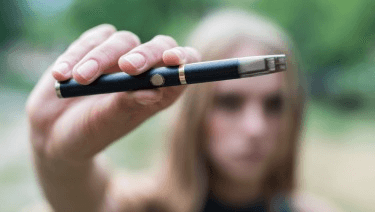
Photo courtesy of American Academy of Pediatrics
By DEBORAH COUNTIE, Pediatrician
“On Aug. 30th, the Centers for Disease Control and Prevention released a health advisory urging people to avoid e-cigarettes and other vaping devices. The CDC states there has been an outbreak of severe lung disease related to vaping resulting in severe illness and death in the US. The American Academy of Pediatrics joins the CDC in its efforts to get the word out and reminds parents that e-cigarette use is never safe for youth or young adults.“
We don’t have time to wait for lawmakers and public health officials to regulate or investigate e-cigarettes. Kids will continue getting injured. They will continue to die as a result of vaping.
Here is what we know: a 2018 national survey found a significant increase in vaping among U.S. teens, hospitals reported increasing numbers of otherwise healthy young people coming into emergency rooms with serious vaping-related illnesses and several young people have even died.
The e-cigarette makers will likely say that these cases (so far) are associated with cartridges they do not sell. So far, that apparently is true. But ingredients in e-cigarette cartridges (liquids that typically contain nicotine, propylene glycol, glycerin, flavorings and other chemicals) can act like a “gateway drug” to other vaped substances.
Even if we overlook these respiratory illnesses linked to vaping, we know that nicotine is highly addictive and harmful to a developing brain.
There is no question that social media, movies, music and TV influence kids’ behavior and can encourage teens to try vaping, but research from the U.S. Centers for Disease Control shows that parents overall have the greatest influence when it comes to tobacco use.
It’s a good bet discussing vaping and e-cigarettes can have the same impact. And now is a good time to talk about this with your teens and pre-teens, whether you think they are vaping or thinking about trying it.
So how can you do this?
Study up
Start by learning more about vaping, types of e-cigarettes and the associated risks. Learn the language, too, to see if words like “juuling” or “juicing” pop up in your teen’s conversations.
Make time to talk
The sooner you start talking, the better – with an emphasis on the word “start.” Don’t view this discussion as a one-time occurrence. Bring up the topic again afterward and often, as you see or hear new developments on the topic.
Listen, don’t lecture
Hear your teen’s perspective. See what they already know – or believe is true. Foster discussion with succinct comments and a lot of give and take. Try starting with an open-ended question such as, “What do you think about vaping?”
Stick to facts
Just saying “vaping is bad for you” usually isn’t effective. During your research, accumulate data, experts’ evidence-based conclusions and how it makes sense to abstain.
Teach them how to say no
When they are offered opportunities to vape, do they know how to respond? Practice with them. Pretend you’re a classmate offering them an e-cigarette. Try to come up with several responses.
Acknowledge your limits
You know you can’t monitor them all the time. Why not make them feel empowered in a positive way? Consider saying something like, “You need to decide for yourself.”
Be an example
If you use tobacco products, it is not too late to quit.
Have that conversation now and help keep our kids safe. Our kids’ health depends on it.
Deborah K. Countie, MD, is a pediatrician at Austin Regional Clinic Wilson Parke in Four Points. For more information, call (737) 247-7200.


